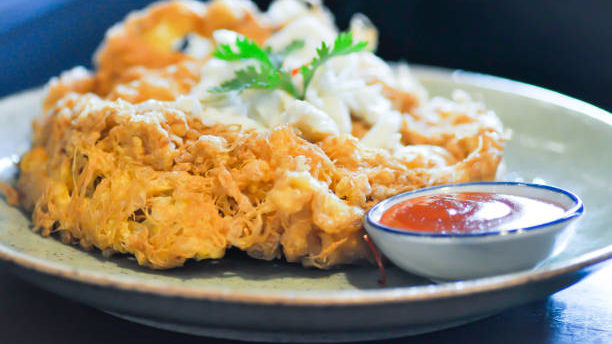This dish makes my mouth water and my stomach rumble. Cook yourself up some traditional Thai Omelette Kai Jiew at any hour of the day for a scrumptious meal.
What is a Traditional Thai Omelette (Kai Jiew)
Traditional Thai Omelette, also known as Kai Jiew, is a yellow golden crispy omelette often served on top of rice or as a complimentary dish to a sour and spicy meal. The eggs are beaten and mixed well with lemon juice and fish sauce. For vegetarians or vegans, you can swap the fish sauce for soy sauce. Kai jiew are sold as Thai street food as well as at high-end restaurants.
Difference Between Western Omelette And Thai Omelette
The traditional omelette is quite different from how the westerners make theirs. The difference all lies in the technique. For Kai Jiew, the eggs are beaten before it is poured into the pan where it is deep-fried.
Western Omelette, on the other hand, is when the beaten eggs are fried in a frying pan with butter or vegetable oil. Milk, cream and or water are sometimes added in. It is then folded with vegetables, meats, cheese, mushrooms. The Thai omelette is instead flipped over in the frying pan.
This dish does not require much seasoning. So instead, the fish or sauce gives the omelette its flavour. You can choose to add in any other ingredients for its fillings such as tomatoes or minced pork, but you can also keep it plain and simple.
History of Omelette
Since we are talking about traditional Thai omelette kai jiew, it is only right to shine the spotlight on the origin of omelette itself. Omelette is believed to have been found as far back as in ancient Persia. A similar dish was created called the Iranian egg dish, kookoo sabzi.
Tips For The Perfect Traditional Thai Omelette
- Beat the egg well. The more you mix it, the lighter and fluffier the omelette will be when it is cooked.
- It is all in the flip. Considering that the omelette has a soft and light texture, it can easily fall apart. You can choose to cook using a large wok that has curved sides instead of a flat pan. Your flipping technique, like anything else, can only get better with practice so start with a small omelette before graduating to a large-sized omelette.
Nutritional Information For Traditional Thai Omelette
Eggs are a great source of protein which is an important building block for muscle and cells. It is also rich in Vitamin B2, B6, B12, vitamin D, and other minerals such as copper, iron, zinc. Depending on which type of egg or brand you choose, it differs on whether it has small or large amounts of omega-3 fatty acids.
Add in plenty of vegetables to your version of the Thai omelette such as tomatoes or onions to add more nutrients to your meal. You can add some meat to increase the protein content and flavour.
Where to Find Traditional Thai Omelette
You can find some Traditional Thai Omellete Kai Jiew at these listed restaurants in Malaysia. Simply Thai is one of the few Thai restaurants you can head to along with others, Kaobahn Kom passion and Thai Thai not far behind the list.
You can find more Thai cuisines on foodpanda!
